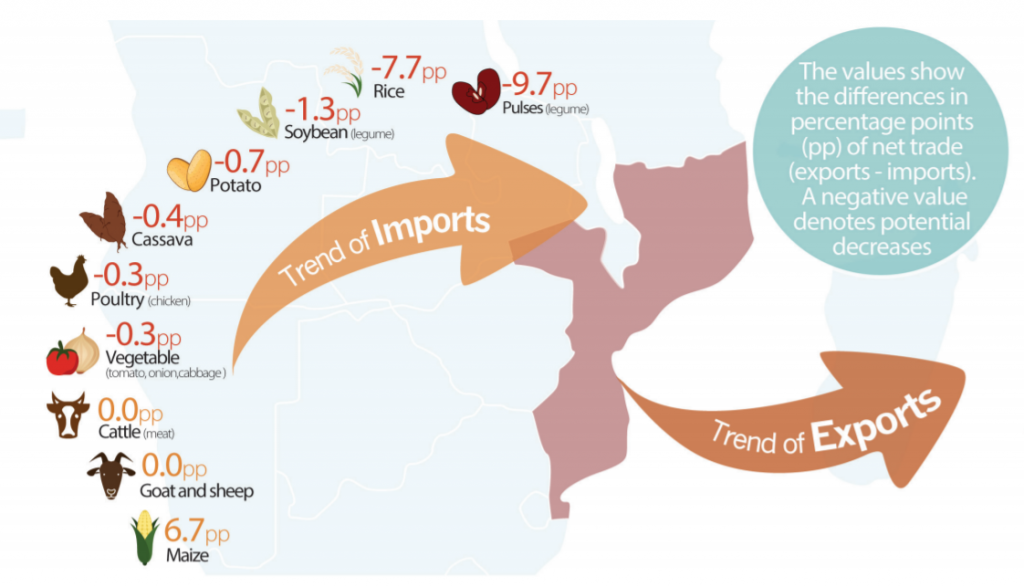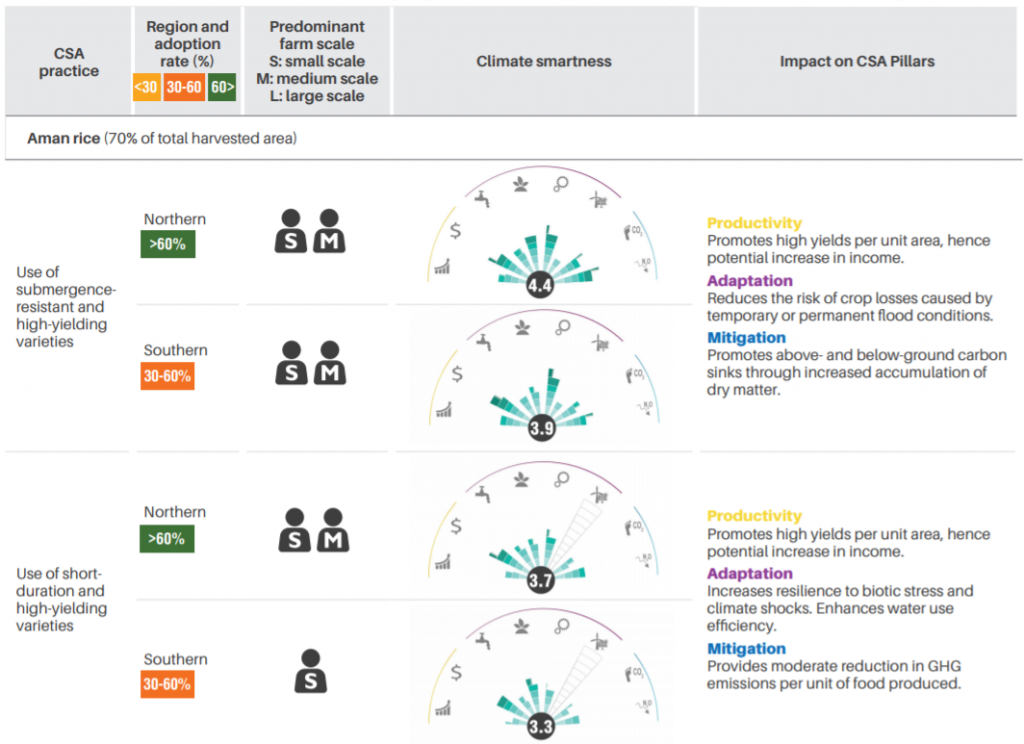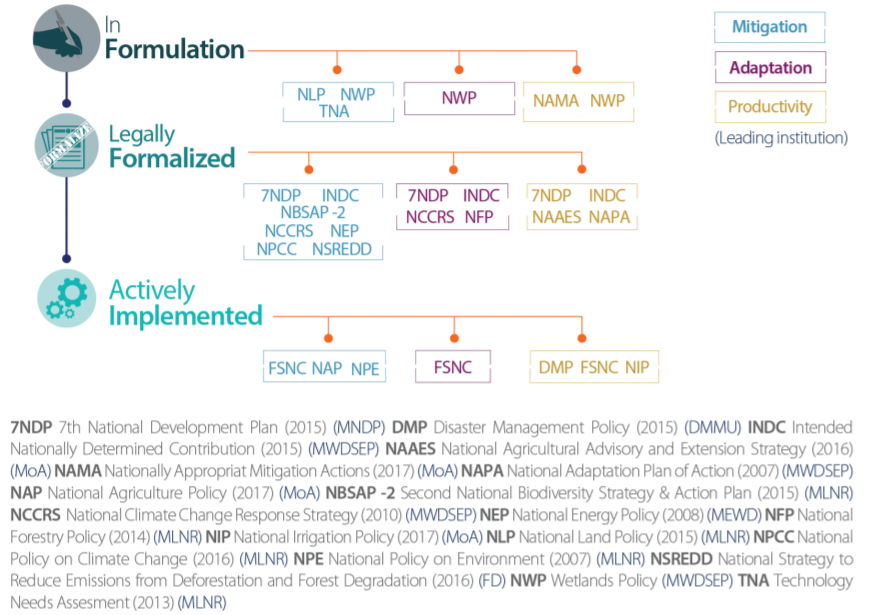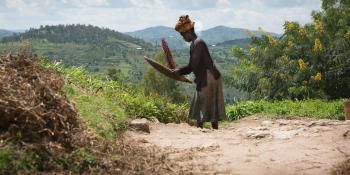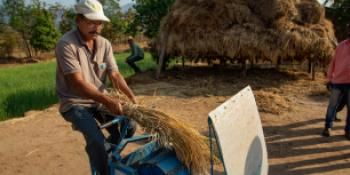Showing the way to climate-smart agriculture around the world

New climate-smart agriculture profiles help countries take the next step in implementing their climate change adaptation and mitigation plans.
Growing impacts of climate change on agricultural production poses major challenges for farmers’ food security and livelihoods. At the same time, to meet the global food demand by 2050, agricultural production must increase by 60%.
Climate-smart agriculture (CSA) addresses the challenges of agriculture and climate change by increasing productivity while enhancing farmers’ resilience and reducing greenhouse gas (GHG) emissions. CSA initiatives consider these three objectives together at different scales (from farm to landscape), at different levels (from local to global), and over short and long time horizons, taking into account national and local specificities and priorities.
The CGIAR Research Program on Climate Change, Agriculture and Food Security (CCAFS) and the International Center for Tropical Agriculture (CIAT), in partnership with the World Bank, CATIE and USAID, have been working together on the CSA Country Profiles publication series that gives an overview of the agricultural challenges in countries around the world, and highlight country-specific CSA practices and technologies and assess their relation to adaptation, mitigation, productivity, institutions and finance. The country profiles help open pathways for sustainably increase productivity, adapt and build resilience to climate change, and reduce GHG emissions where possible.
Read on the CIAT blog: Climate-Smart Agriculture profiles to guide investments in three more African countries
CCAFS and CIAT launched profiles in the last years of Latin America and the Caribbean, Mexico, Peru, Costa Rica, Colombia, El Salvador, Grenada, Nicaragua, Uruguay, Sri Lanka, Rwanda, Kenya, Senegal and Moldova, and new country profiles have recently been released for Mozambique, Tanzania, Zambia, Bangladesh, Bhutan, Nepal, Pakistan and the Philippines.
What do these profiles tell us?
Each country profile describes the relevance of agriculture in the given country, for example, agriculture’s contribution to the country’s gross domestic product, the production systems that are key for food security, agricultural greenhouse gas emissions and the challenges for the agricultural sector.
For example, the country profile for the Philippines details how agriculture is a key economic sector in the Philippines, contributing to approximately 12% of the country’s gross domestic product (GDP) and employing around 32% of the economically active population. A combination of farm characteristics (i.e., small-scale and fragmented), a lack of infrastructure, and policy and institutional barriers has left the sector underdeveloped and unable to meet the food requirements of the growing population. This has resulted in a heavy reliance on food imports, especially wheat and rice, the population’s main staple crops. Top agricultural exports such as banana, coconut, pineapple, and other tropical fruits have the potential to increase growth in the agricultural sector.
The economic relevance of agriculture in the Philippines. Source: Climate-Resilient Agriculture in Philippines
Informative infographics complement the analyses with key knowledge on health, food security and aid, access to basic needs (portable water, electricity, education), land holding and distribution of wealth.
For example, Nepal is endowed with an array of geographical, topographic, climate, and ecological conditions, as well as with diverse cultural norms and social groups. These have led to an uneven transformation of the society and its economy. Agricultural investments need to acknowledge this diversity through targeted interventions that are adapted to different agro-ecologies and farm types. CSA programs must target vulnerable social groups (e.g. women and youth) by making information and resources available and accessible to them. CSA investments not only enhance crop productivity, but can also contribute to improved working conditions for women (e.g., workload, physical burden) and their position in the society. Water harvesting, improved cattle and goat sheds, and biogas production have especially high potential to reduce the drudgery of farming for women.
Tanzania’s population was estimated at 53 million people in 2015, 68% of them residing in rural areas. Despite the country’s remarkable economic growth in recent years, approximately 28% of the population lives below the poverty line and about half with less than US$ 1.90/day. Unemployment rates amount to 86%. Only 15% and 55% of the population have access to electricity and potable water, respectively. Own productive resources is skewed towards men; barely 20% of the women own agricultural land.
| Demographics, access to basic needs and land holding in Nepal. Source: Climate-Smart Agriculture in Nepal | Demograhics, access to basic needs and land holding in Tanzania. Source: Climate-Smart Agriculture in Tanzania |
 |  |
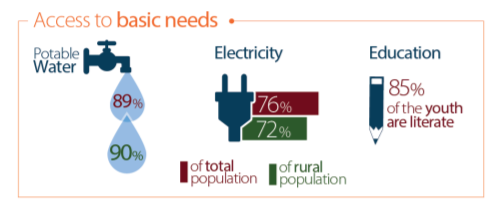 | 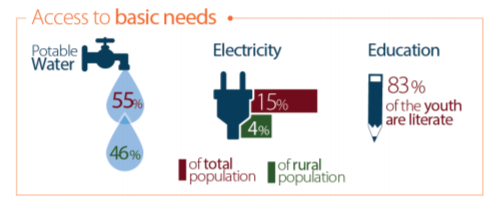 |
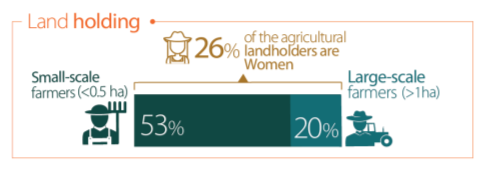 |  |
The profiles detail projected changes in temperature and precipitation in the countries, and the potential economic impacts of climate change on agriculture, including impact of climate change on net trade in the given country between 2020 and 2050.
In Mozambique, independent of climate change, results indicate that by 2050, the country may become more dependent on imports of all major agricultural commodities. However, maize is likely to be particularly affected by climate change with net imports by 2050 expected to be 6.7 percentage points (pp) more under the scenario with climate change as compared to the scenario without climate change. The imports of rice and pulses, on the other hand, are projected to be 7.7 pp and 9.7 pp less under climate change than under the scenario without climate change. The most significant impact of climate change on the cultivated area of analysed crops is projected to be on legumes, which are estimated to cover up to 16 pp less area under the climate change scenario than under the scenario without climate change.
The impact of climate change on net trade in Mozambique (2020-2050). Source: Climate-Smart Agriculture in Mozambique
Climate-smart agriculture technologies and practices present opportunities for addressing climate change challenges, as well as for economic growth and development of the agriculture sector. The CSA country profiles present a selection of already existing CSA practices with high climate smartness scores according to expert evaluations. As climate-smart technologies and practices are highly context-specific, for a given production system the specific CSA practices differ among countries. The country-specific assessment of top ongoing CSA practices provides policy-makers with important scientific evidence on the effectiveness of climate-smart agricultural practices and technologies in the examined countries. Here are a few examples of selected CSA practices from Pakistan and smartness assessment for top ongoing CSA practices from Bangladesh:

Some of the selected CSA practices and technologies for production systems key for food security in Pakistan. Source: Climate-Smart Agriculture in Pakistan
Detailed smartness assessment for top ongoing CSA practices by production system as implemented in Bangladesh. Examples of aman rice and pulses. Source: Climate-Smart Agriculture in Bangladesh
The profiles also share existing institutions and policies that facilitate the scaling up of CSA, and offers analysis on potential financing opportunities for CSA in the countries.
In Zambia, the establishment of the National Climate Change Fund (NCCF) and mainstreaming of CSA into national policies and strategies represent positive steps towards ensuring an enabling institutional and policy environment supportive of CSA. Improved technical and financial capacity of institutions and stakeholders to operationalize these policies and strategies through projects and programmes on the ground remain key for scaling out CSA. Opportunities exist for women and youth to access funds related to CSA through mechanisms such as The National Youth Fund. However, more needs to be done to address the underlying factors which hinder access of women, youth and vulnerable groups to agricultural finance such as land rights (both formal and customary), small land sizes and labour availability.
Policies for CSA in Zambia. Source: Climate-Smart Agriculture in Zambia
In a recent blog post on the CIAT website on the profiles for Zambia, Tanzania and Mozambique, Ivy Kinyua highlights the common issues emerging from the profiles, namely:
the need for strengthening of the national agricultural extension system and extension partners on matters related to CSA; the generation and sharing of evidence to support the promotion and adoption of climate-smart practices at local level – including through sub-national climate risk profiling; ensuring financing is available for CSA practices from public, private and international climate-financing instruments; the engagement and involvement of the private sector in CSA including microfinance, input supply, value addition and marketing; and the need to integrate gender and other crosscutting issues in CSA programming."
Country profiles for climate action in agriculture
Considering the overwhelming priority accorded to agriculture in the NDCs, national level actions in the sector will lead the way, both in adaptation and mitigation. CCAFS researchers estimate that in order to reach the 2C target of the Paris Agreement, emissions from the agricultural sector will need to be reduced by 1 gigatonne carbon dioxide equivalent per year by 2030; current interventions can only achieve 21-40% of this goal. Therefore, transformative changes are needed in the sector. The country profiles can facilitate this change as they provide snapshot of a developing baseline created to initiate discussion at national and global levels about entry points for investing in CSA at scale, and thereby aim contribute to future climate change adaptation and mitigation actions.
Read more:
- Publication series: CSA Country Profiles
- CCAFS research highlight: New country profiles for action on climate-smart agriculture
- CCAFS blog: New Latin America country profiles open pathways for reaching climate-smart agriculture
- CIAT blog: Profiles on climate-smart agriculture presented to standing-room-only World Bank audience
- CIAT blog: Climate-Smart Agriculture profiles to guide investments in three more African countries
Lili Szilagyi is the Communications consultant for the CCAFS Program Management Unit and CCAFS East Africa.


